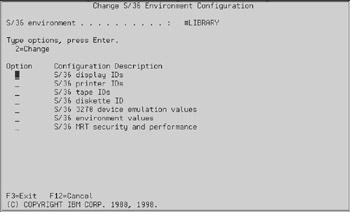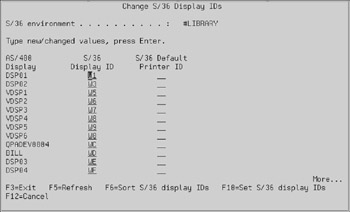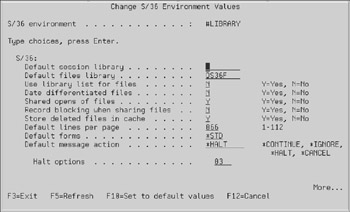Maintaining the Environment
On the S/36, you perform many configuration tasks using the CNFIGSSP procedure. When you use the S/36E, however, you need to use the Change System/36 (CHGS36) command.
The CHGS36 Command
The CHGS36 command can be run only when no users currently are using the S/36E because the i5 must be able to have exclusive use of it during the execution of the CHGS36 command.
The CHGS36 command presents the panel shown in Figure 21.1

Figure 21.1: The CHGS36 environment command.
From this panel, enter an option 2 next to the item you want to maintain and press Enter. The chgs36 command takes you to a secondary panel from which you can perform the maintenance you need to do.
Changing Devices
The first four options in the main panel (Figure 21.1) are used to maintain physical devices that are already connected and configured to the i5. Because the S/36E has different naming requirements, these requirements must be specified in the special panels presented by the S/36E.
For example, the S/36E requires all devices to have two-character names, in accordance with the S/36 naming scheme. Because OCL procedures sometimes refer to a device by name, and because the i5/OS uses device names that can have up to 10 characters, the CHGS36 command lets you assign a System/36-style alias to each device. For example, Figure 21.2 shows the panel from which you maintain display devices.

Figure 21.2: Changing device IDs in the S/36 environment.
As you can see, the display SYSDSP01 has a S/36E equivalent of W2. If a user signs on to SYSDSP01 and starts the S/36E, a substitution expression such as ?WS? returns the value W2. You can change these values if you want. You can also assign a default printer ID for each display station, but this step is optional. To maintain printers, use the panel shown in Figure 21.3

Figure 21.3: Changing printer IDs in the S/36 environment.
This panel is similar to the previous one, but you are maintaining printer IDs instead of display IDs. In addition, you can specify the default lines per inch, characters per inch, and font ID used by each printer.
Changing Environment Values
The most important maintenance option is the one labeled S/36 environment values on the main panel. When you select it with an option 2, you get the panel seen in Figure 21.4.

Figure 21.4: Changing environment values in the S/36 environment.
Some of the entries you may deal with are:
-
Default files library. The S/36E keeps your data files in a single library. When the AS/400 was first designed, the developers forced you to use a library named QS36F to keep all your files. Now you have an option, but QS36F is still the initial value given to this parameter.
-
Use library list for files. You can select to take advantage of the native environments library-list support to locate your files.
-
Shared opens of files. When you select this option, the S/36E behaves like the S/36. Once a file is opened by one program, other programs take less time to access the same file because it is already open.
-
Store deleted files in cache. It is common in S/36 applications to create temporary data files and delete them when they have served their purpose. The i5/OS architecture makes file creation and deletion a time-consuming and resource-intensive process. When the S/36E deletes a file, the file is not actually deleted. The file is only made unavailable. If a subsequent operation requests that the file be created again, the file is made available once more, as an empty file.
EAN: N/A
Pages: 245